It 常见的四个句型
- 格式:doc
- 大小:41.50 KB
- 文档页数:6
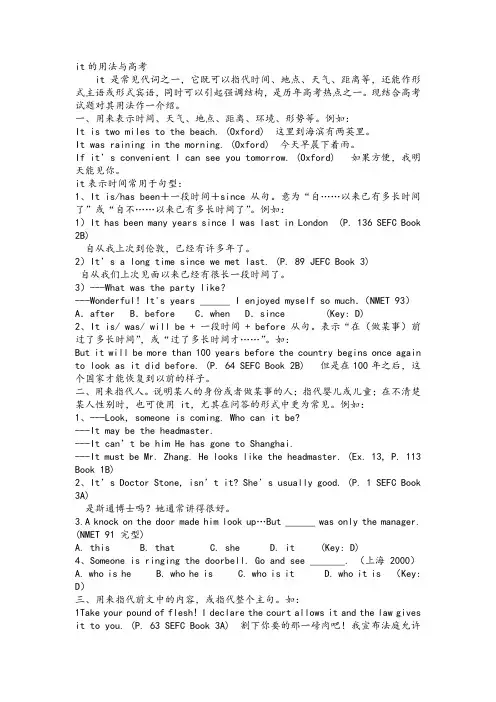
it的用法与高考it是常见代词之一,它既可以指代时间、地点、天气、距离等,还能作形式主语或形式宾语,同时可以引起强调结构,是历年高考热点之一。
现结合高考试题对其用法作一介绍。
一、用来表示时间、天气、地点、距离、环境、形势等。
例如:It is two miles to the beach. (Oxford) 这里到海滨有两英里。
It was raining in the morning. (Oxford) 今天早晨下着雨。
If it’s convenient I can see you tomorrow. (Oxford) 如果方便,我明天能见你。
it表示时间常用于句型:1、It is/has been+一段时间+since 从句。
意为“自……以来已有多长时间了”或“自不……以来已有多长时间了”。
例如:1)It has been many years since I was last in London (P. 136 SEFC Book 2B) 自从我上次到伦敦,已经有许多年了。
2)It’s a long time since we met last. (P. 89 JEFC Book 3)自从我们上次见面以来已经有很长一段时间了。
3)---What was the party like?---Wonderful!It's years ______ I enjoyed myself so much.(NMET 93)A.after B.before C.when D.since (Key: D)2、It is/ was/ will be + 一段时间+ before 从句。
表示“在(做某事)前过了多长时间”,或“过了多长时间才……”。
如:But it will be more than 100 years before the country begins once again to look as it did before. (P. 64 SEFC Book 2B) 但是在100年之后,这个国家才能恢复到以前的样子。
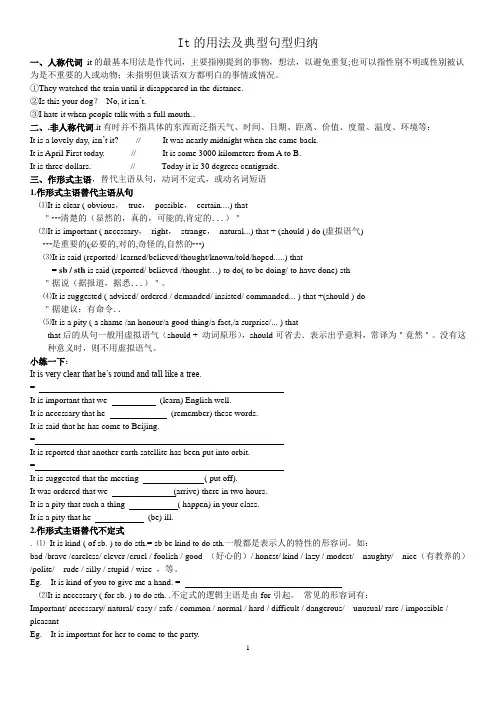
It的用法及典型句型归纳一、人称代词it的最基本用法是作代词,主要指刚提到的事物,想法,以避免重复;也可以指性别不明或性别被认为是不重要的人或动物;未指明但谈话双方都明白的事情或情况。
①They watched the train until it disappeared in the distance.②Is this your dog?No, it isn’t.③I hate it when people talk with a full mouth..二、.非人称代词.it有时并不指具体的东西而泛指天气、时间、日期、距离、价值、度量、温度、环境等:It is a lovely day, isn’t it? // It was nearly midnight when she came back.It is April First today. // It is some 3000 kilometers from A to B.It is three dollars. // Today it is 30 degrees centigrade.三、作形式主语,替代主语从句,动词不定式,或动名词短语1.作形式主语替代主语从句⑴It is clear ( obvious,true,possible,certain....) that"┅清楚的(显然的,真的,可能的,肯定的...)"⑵It is important ( necessary,right,strange,natural...) that + (should ) do (虚拟语气)┅是重要的(必要的,对的,奇怪的,自然的┅)⑶It is said (reported/ learned/believed/thought/known/told/hoped.....) that= sb / sth is said (reported/ believed /thought…) to do( to be doing/ to have done) sth"据说(据报道,据悉...)"。
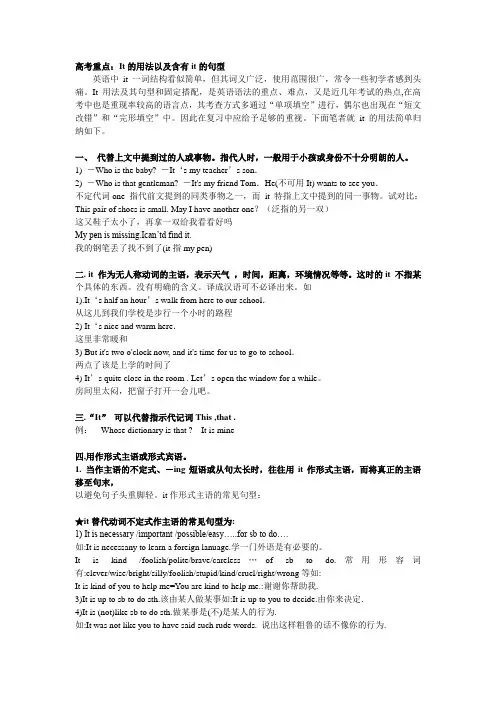
高考重点:It的用法以及含有it的句型英语中it 一词结构看似简单,但其词义广泛,使用范围很广,常令一些初学者感到头痛。
It用法及其句型和固定搭配,是英语语法的重点、难点,又是近几年考试的热点,在高考中也是重现率较高的语言点,其考查方式多通过“单项填空”进行,偶尔也出现在“短文改错”和“完形填空”中。
因此在复习中应给予足够的重视。
下面笔者就it的用法简单归纳如下。
一、代替上文中提到过的人或事物。
指代人时,一般用于小孩或身份不十分明朗的人。
1) -Who is the baby? -It‘s my teacher’s son.2) -Who is that gentleman? -It's my friend Tom.He(不可用It) wants to see you.不定代词one 指代前文提到的同类事物之一,而it 特指上文中提到的同一事物。
试对比:This pair of shoes is small. May I have another one?(泛指的另一双)这又鞋子太小了,再拿一双给我看看好吗My pen is missing.Ican’td find it.我的钢笔丢了找不到了(it指my pen)二. it 作为无人称动词的主语,表示天气,时间,距离,环境情况等等。
这时的it 不指某个具体的东西。
没有明确的含义。
译成汉语可不必译出来。
如1).It‘s half an hour’s walk from here to our school.从这儿到我们学校是步行一个小时的路程2) It‘s nice and warm here.这里非常暖和3) But it's two o'clock now, and it's time for us to go to school.两点了该是上学的时间了4) It’s quite close in the room . Let’s open the window for a while。
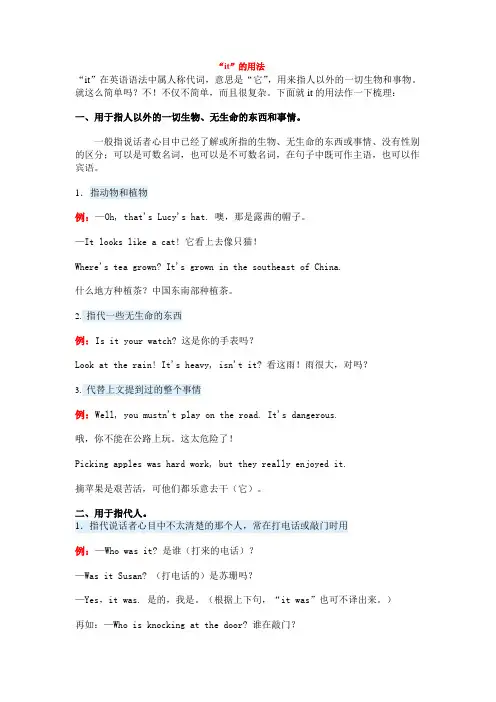
“it”的用法“it”在英语语法中属人称代词,意思是“它”,用来指人以外的一切生物和事物。
就这么简单吗?不!不仅不简单,而且很复杂。
下面就it的用法作一下梳理:一、用于指人以外的一切生物、无生命的东西和事情。
一般指说话者心目中已经了解或所指的生物、无生命的东西或事情、没有性别的区分;可以是可数名词,也可以是不可数名词,在句子中既可作主语,也可以作宾语。
1.指动物和植物例:—Oh, that's Lucy's hat. 噢,那是露茜的帽子。
—It looks like a cat! 它看上去像只猫!Where's tea grown? It's grown in the southeast of China.什么地方种植茶?中国东南部种植茶。
2.指代一些无生命的东西例:Is it your watch? 这是你的手表吗?Look at the rain! It's heavy, isn't it? 看这雨!雨很大,对吗?3.代替上文提到过的整个事情例:Well, you mustn't play on the road. It's dangerous.哦,你不能在公路上玩。
这太危险了!Picking apples was hard work, but they really enjoyed it.摘苹果是艰苦活,可他们都乐意去干(它)。
二、用于指代人。
1.指代说话者心目中不太清楚的那个人,常在打电话或敲门时用例:—Who was it? 是谁(打来的电话)?—Was it Susan? (打电话的)是苏珊吗?—Yes,it was. 是的,我是。
(根据上下句,“it was”也可不译出来。
)再如:—Who is knocking at the door? 谁在敲门?—It's me. 是我。
2.指说话者心目中的那个人例:—Is it your sister, Kate? (那旧照片上的 baby)是你姐姐凯特吧?—No! 不是。
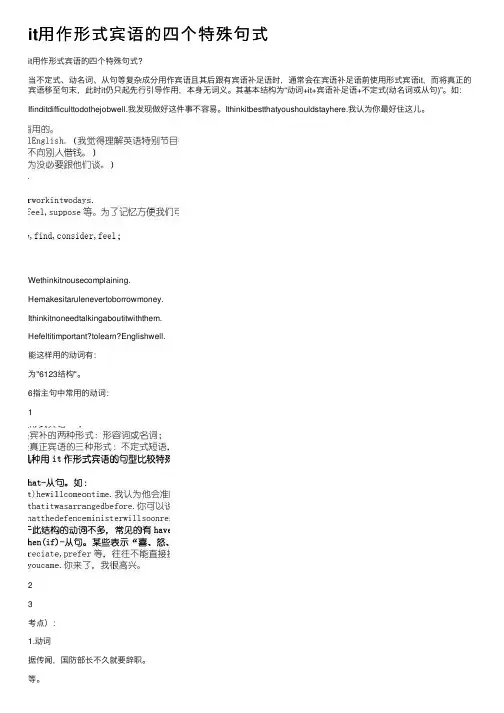
it⽤作形式宾语的四个特殊句式it⽤作形式宾语的四个特殊句式?当不定式、动名词、从句等复杂成分⽤作宾语且其后跟有宾语补⾜语时,通常会在宾语补⾜语前使⽤形式宾语it,⽽将真正的宾语移⾄句末,此时it仍只起先⾏引导作⽤,本⾝⽆词义。
其基本结构为“动词+it+宾语补⾜语+不定式(动名词或从句)”。
如:Ifinditdifficulttodothejobwell.我发现做好这件事不容易。
Ithinkitbestthatyoushouldstayhere.我认为你最好住这⼉。
Wethinkitnousecomplaining.Hemakesitarulenevertoborrowmoney.Ithinkitnoneedtalkingaboutitwiththem.Hefeltitimportant?tolearn?Englishwell.能这样⽤的动词有:为"6123结构"。
6指主句中常⽤的动词:123考点):1.动词据传闻,国防部长不久就要辞职。
等。
2.动词like,enjoy,love,hate,Wereallyappreciateitwhensheofferedtohelp.她来帮忙了,我们⼗分感激。
I’dpreferitifIdidn’thavetodo somuchwork.要是我不必做那么多⼯作,好就太好了。
3.动词+prep+it+that-从句。
that引导的宾语从句不能直接作介词的宾语。
如:Seetoitthatyou’renotlateagain.注意千万不要再迟到。
Looktoitthatthisdoesn’thappenagain.注意不要再发⽣这种事。
Ican’tanswerforitthathewillcome.我不能保证他会来。
Youmayrelyonitthathe’llcometomeetyou.你放⼼,他会来接你的。
Youmaydependonitthatweshallalwayshelpyou.(尽管放⼼,我们会随时帮你的。
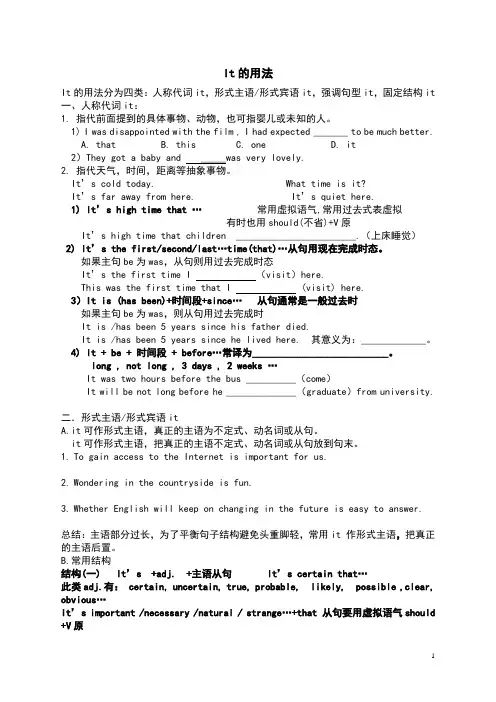
It的用法It的用法分为四类:人称代词it,形式主语/形式宾语it,强调句型it,固定结构it一、人称代词it:1. 指代前面提到的具体事物、动物,也可指婴儿或未知的人。
1) I was disappointed with the film , I had expected _______ to be much better.A. thatB. thisC. oneD. it2)They got a baby and _____was very lovely.2. 指代天气,时间,距离等抽象事物。
It’s cold today. What time is it?It’s far away from here. It’s quiet here.1) It’s high time that …常用虚拟语气,常用过去式表虚拟有时也用should(不省)+V原It’s high time that children ________________________.(上床睡觉)2) It’s the first/second/last…time(that)…从句用现在完成时态。
如果主句be为was,从句则用过去完成时态It’s the first time I (visit)here.This was the first time that I (visit) here.3)It is (has been)+时间段+since…从句通常是一般过去时如果主句be为was,则从句用过去完成时It is /has been 5 years since his father died.It is /has been 5 years since he lived here. 其意义为:_____________。
4) It + be + 时间段 + before…常译为___________________________。
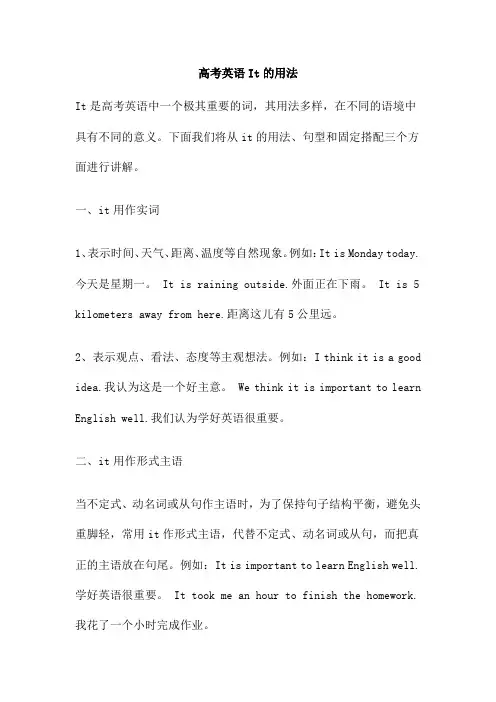
高考英语It的用法It是高考英语中一个极其重要的词,其用法多样,在不同的语境中具有不同的意义。
下面我们将从it的用法、句型和固定搭配三个方面进行讲解。
一、it用作实词1、表示时间、天气、距离、温度等自然现象。
例如:It is Monday today.今天是星期一。
It is raining outside.外面正在下雨。
It is 5 kilometers away from here.距离这儿有5公里远。
2、表示观点、看法、态度等主观想法。
例如:I think it is a good idea.我认为这是一个好主意。
We think it is important to learn English well.我们认为学好英语很重要。
二、it用作形式主语当不定式、动名词或从句作主语时,为了保持句子结构平衡,避免头重脚轻,常用it作形式主语,代替不定式、动名词或从句,而把真正的主语放在句尾。
例如:It is important to learn English well.学好英语很重要。
It took me an hour to finish the homework.我花了一个小时完成作业。
三、it用作形式宾语当不定式、动名词或从句作宾语时,为了保持句子结构平衡,避免头重脚轻,常用it作形式宾语,代替不定式、动名词或从句,而把真正的宾语放在句尾。
例如:I think it is important to learn English well.我认为学好英语很重要。
He found it hard to learn English well.他发现学好英语很难。
四、it用于强调句型中强调句型是英语中一个重要的句型,用于突出强调某个成分,特别是主语、宾语和状语等。
在强调句型中,it没有实际意义,只是起到引导作用。
例如:It is I who am the best student in my class.我是班里最好的学生。
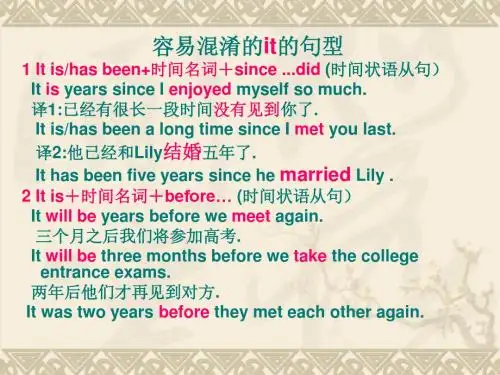

常用it作形式主语的句型结构◇It + be +形容词+ that-从句可用于此句型的形容词有: wonderful,true,good,right,wrong,(un)important,useless,surprising,clear,unusual,lucky,certain, necessary等。
如:①It is quite certain that he will be at the meeting.②It is surprising that he came late to school this morning.③It is important that we(should)study hard注意: 该句型中的形容词是(un)important, necessary等时,从句应为(should )+动词原形。
◇It + be + -ed 分词+ that-从句适用该句型的过去分词主要有: said,reported,announced,hoped,thought,told,believed,expected,decided,suggested,known等。
如:①It is hoped that one day they will have enough animals to set them free②It is well known that the earth goes around the sun.③It is suggested that the sports meeting (should ) be put off until next week. 注意: 该句型的过去分词是suggested时,从句应为(should )+动词原形。
◇It + be +名词+ that-从句适用该句型的名词(词组)有: a pity,an honor,a good thing,a fact,a surprise,good news, one’s duty等。
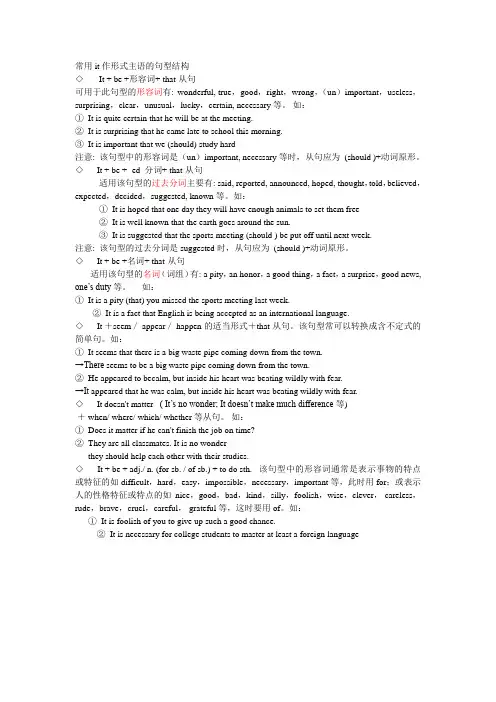
常用it作形式主语的句型结构◇It + be +形容词+ that-从句可用于此句型的形容词有: wonderful, true,good,right,wrong,(un)important,useless,surprising,clear,unusual,lucky,certain, necessary等。
如:①It is quite certain that he will be at the meeting.②It is surprising that he came late to school this morning.③It is important that we (should) study hard注意: 该句型中的形容词是(un)important, necessary等时,从句应为(should )+动词原形。
◇It + be + -ed 分词+ that-从句适用该句型的过去分词主要有: said, reported, announced, hoped, thought,told,believed,expected,decided,suggested, known等。
如:①It is hoped that one day they will have enough animals to set them free②It is well known that the earth goes around the sun.③It is suggested that the sports meeting (should ) be put off until next week.注意: 该句型的过去分词是suggested时,从句应为(should )+动词原形。
◇It + be +名词+ that-从句适用该句型的名词(词组)有: a pity,an honor,a good thing,a fact,a surprise,good news, one’s duty等。
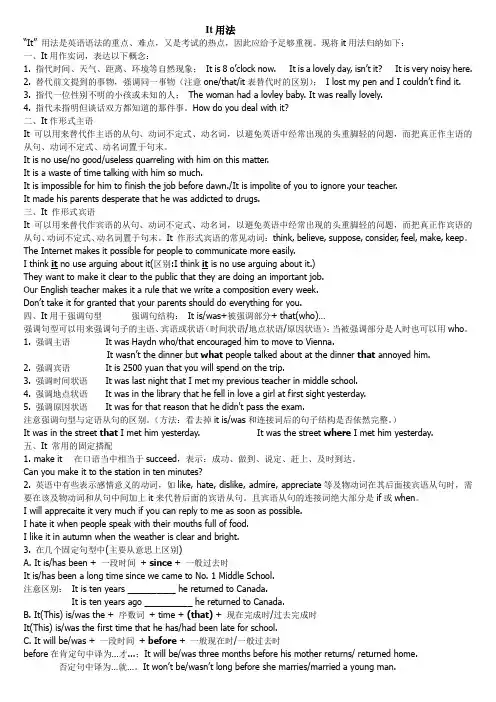
It用法“It” 用法是英语语法的重点、难点,又是考试的热点,因此应给予足够重视。
现将it用法归纳如下:一、It用作实词,表达以下概念:1. 指代时间、天气、距离、环境等自然现象;It is 8 o’clock now. It is a lovely day, isn’t it? It is very noisy here.2. 替代前文提到的事物,强调同一事物(注意one/that/it表替代时的区别);I lost my pen and I couldn’t find it.3. 指代一位性别不明的小孩或未知的人;The woman had a lovley baby. It was really lovely.4. 指代未指明但谈话双方都知道的那件事。
How do you deal with it?二、It作形式主语It可以用来替代作主语的从句、动词不定式、动名词,以避免英语中经常出现的头重脚轻的问题,而把真正作主语的从句、动词不定式、动名词置于句末。
It is no use/no good/useless quarreling with him on this matter.It is a waste of time talking with him so much.It is impossible for him to finish the job before dawn./It is impolite of you to ignore your teacher.It made his parents desperate that he was addicted to drugs.三、It 作形式宾语It可以用来替代作宾语的从句、动词不定式、动名词,以避免英语中经常出现的头重脚轻的问题,而把真正作宾语的从句、动词不定式、动名词置于句末。
It 作形式宾语的常见动词: think, believe, suppose, consider, feel, make, keep。
“It”用法及其句型和固定搭配一、It用作实词表达以下概念:指代前文提到的事物,前文中的this, that;替代前文中的内容;指代一位性别不明的小孩或未知的人;指代未指明但谈话双方都知道的那件事;指代时间、天气、气候、距离等自然现象……二、It用作形式主语1. It替代作主语的从句常见句型(1) It is + noun +从句例 It is no secret that the president wants to have a second term at office.(2) It is adj. +clauseIt's surprising that…(should)………竟然……It's a pity/shame that…(should)………竟然……(3) It verb sb. + clause= It is v-ing + clauseIt+surprise/delight/interest/disappoint/worry/disturb/annoy/amaze /bother/concern/frighten/please/anger sb. that …(4) It is v-ed that…=sb/sth is to do(verb=say, report, think, believe, hope, expect, agree, accept, decide, determine, intend, plan, understand, know) (5) It is v-ed that …(should)…(verb=demand, request, require, order, suggest, advise, recommend 例 It is suggested that they should beg in with the third question.三、It作主语的句型1. It's (just)(un)like sb. to do某人的风格2. It's (about/high) time that… should /v-ed…3. It's the x-th time (that) … have v-ed…4. It is/has been… since …continuous v-ed(延续性动词) 某动作已有多长时间不发生了5. It was(not)…before…例 It was not long before they arrived.四、It 作形式宾语用来替代作宾语的从句、动词不定式、动名词,而把真正作宾语的从句、动词不定式、动名词置于句尾。
避免头重脚轻的it句型在英语中,为了避免头重脚轻,保持句子平衡,经常运用it作形式主语或形式宾语,而把真正的主语或宾语后置,作真正主语或宾语的常为不定式或从句,有时也可用动名词。
it 有时也可以用在一些固定句型中。
灵活地运用it句式可使文章更高级,结构更紧凑。
一、it作形式主语的常用句型1.It takes (sb.) some time/energy/effort...to do sth.It took the students about two hours to finish cleaning the classroom that day.那天花了同学们大约两个小时才把教室打扫完。
2.It is/was+名词/形容词+(of/for sb.) to do sth.Honestly speaking,it’s so nice of you to offer me a class of practical learning skills.说实话,你能给我上一堂实用的学习技巧课真是太好了。
(2019·浙江)It’s indeed a pleasant surprise for me to even rank first in a recent English speech contest.在最近的一次英语演讲比赛中,我竟然名列第一,真是令人惊喜。
(2019·浙江)3.It is/was+名词/形容词/过去分词+that...It is true that the Internet plays an important role in our daily life.确实,网络在我们的日常生活中扮演重要的角色。
It’s said that rap music was invented by a classical musician in 1912.据说,说唱音乐是一位古典音乐家在1912年创立的。
It 的13 个常用句型及其运用!书面表达必备!It 的13 个常用句型及其运用it 虽然并不显眼,但只要运用得当,也能在书面表达中发挥出巨大的作用,给人以高大上的感觉。
本文在归纳其常用的句式结构的基础上着眼于在书面表达中如何恰当地运用it 的相关句型,以达到优化句子,增加文章亮点。
01一、it 句型的归纳:( 一) it 作形式主语的 6 个句型句型1. It is + adj. (=of n.) + for sb. to do sth. / that... 某人做某事是……的。
Will it be convenient for you to start work tomorrow? 你明天开始工作方便吗?It is vital /of great significance for students to take regular exercise. = It is vital /of great significance that students should take regular exercise. 定期进行锻炼这对学生来说太重要了。
句型2. It is a shame / pity that... 很遗憾……(1) It is a shame that some students should scribble and litterrandomly on the campus. 一些学生竟然在校园中乱涂乱画,乱扔垃圾,这真是太不应该了。
(2) It is a pity that I cannot go to see the movie on Saturday evening. 很遗憾,周六晚上我没办法陪您去看电影了。
说明: that 引导的从句为主语从句,从句中谓语动词的语气分两种情况:①表述的内容是事实,用陈述语气 , 如例句 (2) ;②若内容表明说话人的一种语气 / 情感则使用虚拟语气 , 如例句 (1) 。
高中英语语法It的用法总结一、It 用作实词表达以下概念:指代前文提到的事物,如前文中的this, that;替代前文中的内容;指代一位性别不明的小孩或未知的人;指代未指明但谈话双方都知道的那件事;指代时间、天气、气候、距离等自然现象……二、It 用作形式主语替代作主语的从句、动词不定式、动名词,而把真正作主语的从句、动词不定式、动名词置于句尾。
It 作形式主语的常见句型:1. 代作主语的动词不定式,其句型为:(1) It be adj. (for sb.) to do sth.此处adj. 通常为描述事件的形容词:easy, difficult, hard, necessary, unnecessary, possible, impossible, likely, unlikely, right, wrong, important, unimportant, legal, illegal, well-mannered, ill-mannered, polite, impolite, clear, obvious, certain, suitable, proper, fit, useful, useless, dangerous…例: It is illegal (for a teenager) to drive a car without a license.(2) It be adj. of sb. to do sth.此处adj. 通常为描述人的形容词:kind, unkind, nice, rude, cruel, considerate, thoughtful, thoughtless, careful, careless, silly, foolish, stupid, clever, wise, crazy.例: It's kind of you to help me with the problem.(3) It替代作主语的动名词的常见句型:It's no good/use doing…It's (well)worth doing…It's (well)worth one's while doing/to do…It's (well)worth while doing/ to do例: It's no use crying over spilt milk(覆水难收).2. It替代作主语的从句常见句型:(1) It is + noun +从句例: It is no secret that the president wants to have a second term at office.(2) It is adj. +clauseIt's surprising that… (should)………竟然……It's a pity/shame that…(should)………竟然……例: It's important that you should apologize to her for your rudeness.(=It's of much importance that you should apologize to her for your rudeness.)(3) It verb sb. + clause= It is v-ing + clauseIt+surprise/delight/interest/disappoint/worry/disturb/annoy/amaze/bother/concern/frighten/please/anger sb. that…例: It worried me that she drove so fast.(= It was worrying that she drove so fast.)(4) It verb (to sb.) that…= sb/sth verb to do例: It (so) happened/chanced that they were out.(= They happened/chanced to be out.)(5) It is v-ed that…=sb/sth is to do(verb=say, report, think, believe, hope, expect, agree, accept, decide, determine, intend, plan, understand, know)例: It is said that the couple have gotten divorced.(=The couple are said to have gotten divorced.)(6) It is v-ed that … (should)…(verb=demand, request, require, order, suggest, advise, recommend例It is suggested that they should begin with the third question.三、It 作主语的句型1. It takes sb. … to do…(=sb takes…to do…)某人用多长时间做某事例: It took the men a week to mend our roof.(= The men took a week to mend our roof.)2. It's (just)(un)like sb. to do…(不)像某人做某事的风格例: It was (just) like him to think of helping us.3. It's (about/high) time that… should /v-ed…是该做某事的时候了例: It's(about/high) time that we should take action.4. It's the x-th time (that) … have v-ed…第几次做某事了例: It's the third time that he has failed the driving test.5. It is/has been… since …continuous v-ed(延续性动词) 某动作持续了多长时间例: It's 10 years since he lived here6. It was(not)… before…过(不)了多长时间某动作发生了例: It was not long before they arrived.四、It 作形式宾语用来替代作宾语的从句、动词不定式、动名词,而把真正作宾语的从句、动词不定式、动名词置于句尾。
It 常见的四个句型It seemed only several minutes ________ he made up his mind and told us his decision.A.thatB.sinceC.whenD.before记住四个句型,能帮助你又快又正确做这样的题。
1. It was +时间点+ when sth. happened. 表示:当某件事发生时,时间(it)是。
如:It was 1997 when Hongkong returned to China.2. It was +时间段+before sth. happened. 此句型前必有前文,表示在那件事发生之后,另一件事发生之前,这两点之间的时间是多长。
如接上句:It was two years before Macao returned to China too. 过了两年,澳门也回归了。
注:这个句型有两种情况,两种译法:2 a. It was a long time before sth. happened. 过了很久,才发生另一件事。
2 b. it wasn't long before sth. happened. 没过多久,另一件事也发生了。
3. It is( = has been) +时间段+ since sth. happened. 意为:自从过去某件事发生以来,到现在已经有一段时间了。
如:It is (=has been) 13 years since Hongkong returned to China.4. 强调句型:It was +被强调的部分+that+剩余部分。
举一个与例一很近的例子:It was in 1997 that Hongkong returned to China.原句为:Hongkong returned to China in 1997. 强调状语in 1997.本题只不过将系动词was改成了seemed, 属于2b句型。
译:好象没过几分钟他就下定了决心,并告诉了我们他的决定。
另注:这个句型还有将来时态:It will be some time before sth. happens. 要过多久才会发生某事。
It won't be long before sth. happens.不用过多久就会发生某事。
He was about halfway through his meal_______a familiar voice came to his ears.A.why B.where C.when D.while解析:答案是C。
此处when作并列连词,表示“就在此刻(and just then)”,“突然(and suddenly)”,由此借以引出追叙的事项。
该句译为:“饭刚吃到一半儿的时候,熟悉的声音传到了他的耳朵里。
”在中学英语中,我们经常见到与并列连词when相关的句式,现将其归纳如下:1.be (just) about to do... when...She was just about to say something more when she noticed the sullen look on his face.她刚要再说些什么,却突然看到了他阴沉的脸色。
We were about to telephone you when your telegram arrived.我们正准备给你打电话,这时你的电报来了。
2.be (just) on the point of doing sth... when...They were on the point of giving up when the captain encouraged them fiercely to save the ship.就在他们快要放弃努力时,船长鼓励他们竭尽全力挽救轮船。
The coach was just on the point of giving up the game when our team scored two points.教练正准备放弃比赛,这时我们队得了两分。
3.be going to do...when...He was going to run away,when the policemen came.他正打算逃跑,警察突然出现了。
She was going to open the window and shout at the dog to frighten it,when she stopped and stood quite still.她正准备打开窗户,大声吓唬一下那条狗,这时她突然停住了,站着一动也不动。
4.be doing sth ...when...The children are playing football on the playground,when it began to rain.孩子们正在操场上踢足球,突然下起了大雨。
A few days later,I was moving forward over a slope that seemed safe when suddenly without warning my world dropped out from under my skis.(必修本SEFC Book 1 Unit 17) 几天以后,我正在一个似乎安全的斜坡上前行,突然,毫无预兆,滑雪板下的大地陷下去了。
5.be busy doing...when...I was busy doing my homework when one of my classmates came.我正忙着做作业,这时我的一个同学来找我。
I was busy cooking when there was a knock at the door.我正在忙着做饭,突然听到了敲门的声音。
6.had (just) done...when...I had just gone to bed after a very hard day when the phone rang.在劳累了一天之后,我刚要上床睡觉,这时电话响了。
I had travelled only two hours one day when the winds increased so much that I had to put my tent up before the winds became too strong.(必修本SEFC Book 1 Unit17) 一天,我刚走了两个小时,突然狂风大作,我只好趁风力还不算太大之前,支起帐篷。
7.had not done...when...I hadn’t walked a few steps when I realized that he asked for the direc-tion to my office building.我还没走出去几步远,突然意识到他问的是去办公大楼的方向。
The students hadn’t played basketball long when the bell rang.学生们没玩多长时间篮球,铃就响了。
8.be + 介词短语+ when...He was on his way to a lecture when a tourist stopped him and asked him for directions.在他去听课的路上,一名游客拦住他问路。
The mother and the seven-year-old were inside the house when the shooting occurred.这位母亲和她7岁的孩子正在家里的时候,发生了枪击事件。
练习:1.I has just stepped out of the bathroom and was busily drying myself with a towel I heard the steps. (2006年湖南卷)A.while B.when C.since D.after2.I was still sleeping when the fire ,and then it spread quickly.(2006年广东卷)A.broke out B.put out C.came out D.got out3.I_______along the street looking for a place to park when the accident_______(2006年安徽卷)A.went; was occurring B.went; occurredC.was going; occurred D.was going; had occurred4.We were swimming in the lake suddenly the storm started.(2004年春季北京卷)A.when B.while C.until D.before5.Jasmine was holidaying with her family in a wildlife park_______she was bitten on the leg by a lion.(2004年上海卷)A.when B.while C.since D.once6.He was about to tell me the secret_______someone patted him on the shoulder.(2002年上海卷)A.as B.until C.while D.when参考答案:1.B2.A3.C4.A5.A6.D1.How long表示“时间多久或物体多长”. 表示时间侧重指“一段时间”.针对“How long” 的回答一般是时间段,如“for three days”, “three years”e.g. “How long were you away last year?”“About two weeks”3. How often表示“多少时间一次或每隔多久”.是就做某事的频率提问。
针对How often的回答一般是“Twice a year”. “Three times a week”.e.g. “How often do you watch TV?”“Tree times a week.”3. How soon表示“多久之后”.侧重某人某事能多快时间完成. How soon的回答一般为: “ in + 时间段” e.g. “ in two days” “in five years”e.g. “How soon will you be ready?”“I’ll be ready in five minutes”4.How far表示“多远”How far is it?[巩固练习]1. I don’t know_______ he will get here.A. how longB. how soonC. how oftenD. how many answer B2. “_____does he take this medicine?”“Twice a day.”A. How soonB. How longC. How muchD. How often answer D3. “_______have you been at this factory?”“I have been here since 1993.”A. WhenB. How longC. How oftenD. What time answer B4. “________can you finish this work?”A. How oftenB. How soonC. How longD. How far answer B5. “__________ will he stay here?”A. How many timesB. How oftenC. what timeD. How long answer D6. _______does your sister write to your parents?A. How manyB. How often c. How long D. How far answer B7. ________does it take you to finish you homework every day?A. How longB. How oftenC. How soonD. How much answer A反意疑问句考点反意疑问句是高考重要考点,其构成形式是"肯定+ 否定"和"否定+ 肯定",但也有一些特例。